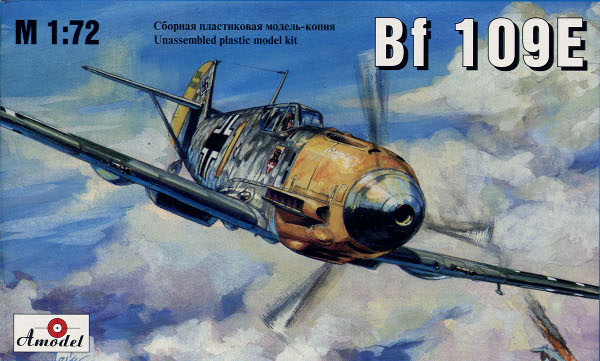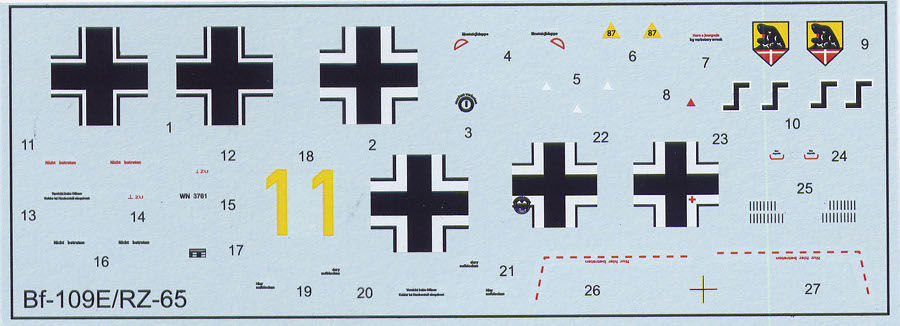
A-Model 1/72 Bf 109E-3
By Jacob Russell
The Plane
The Bf109E or Emil was the first major production model of the Bf109. It utilized the Daimler Benz DB601 inverted V-12 engine with direct fuel injection. The Bf109E-3 used the DB 601a engine and was produced in large numbers starting in 1939. The armament comprised 2 MG 17 machine guns in the upper cowl and a pair of wing mounted MG FF cannon, which was a distinct improvement over the MG 17 machine guns mounted in the wings of the earlier E-1 series. The E-3 saw considerable action in the early phase of World War Two.
The Model
This is a limited-run kit that appears to be based on the old tool Hasegawa Bf109. The landing gear and mainwheels are identical, as are the shallow cowling gun troughs. The kit is comprised of 45 parts, one of which is clear, the canopy. The other parts are attached to 3 sprues and some of the attachment points are larger than the parts themselves, so be careful removing them from the sprues. There is no sidewall detail on the inner fuselage halves but the panel lines on the wings and fuselage are quite good. There are some sinkmarks on the lower rear fuselage and some roughness on the upper port tailplane. Bonus parts include a tropical filter, 2 different spinners, and ETC 50/VIIId and ETC 500 bomb racks. There are also 4 SC bombs and one SC 250 bomb for the racks. You also get a 300 gallon drop tank and a lower fuselage camera housing for the Rb 21/18 camera equipped E-5 reconnaissance fighter. Plus you get a pilot figure who looks like he was shot at close range with a shotgun, thanks to an enormous sinkmark in his chest. The bomb racks, bombs, drop tank, camera housing, and pilot figure are attached to a single sprue which is included in all of A-Model's 109 kits, so it is a nice bonus. This sprue also includes a pair of underwing "gondola" cannon for the later 109G "Kannonenboote" variants.
There is a single decal option provided in the kit, “Yellow 1”, the Bf109E-3 of Hans Phillip, Staffelkapitän of 4./JG 54, stationed in France in 1940. This plane was painted in RLM 71/02 over RLM 65, with fuselage mottles in 71/02. The cowl and rudder are RLM 04 yellow, and the spinner is half white, half RLM 71. The decal sheet has A-Model's customary matte carrier film and includes 18 victory markings for both sides of the rudder, although the numbers for the individual fuselage sections are omitted. The decals are in register, legible and well printed. I think the decals will be quite useable if you spray them with a coat of clear gloss.

Accuracy
The kit is pretty accurate. I compared the kit wings and fuselage to 1/72nd scale plans in the AJ Press book, Messerschmitt Bf109 Part 1. The wings are slightly narrow in chord but spot on in width. The fuselage is not quite deep enough in height, and slightly short in length between the cockpit and base of the fin. But the kit passes the ultimate test in that it looks like a Bf109E. The fuselage in Tamiya's 1/72nd scale Bf109E kits is also too short, and ICM's recent Bf109E kits are generally regarded as the most dimensionally accurate .
The aircraft number on both the box top and decal sheet are yellow but my references indicate that the 4th Staffel numbers for Staff Flight aircraft should be white rather than yellow.
Conclusion
This is a pretty good kit. It is reasonably accurate in overall dimensions, but compromised by the quality of smaller detail parts such as the aileron mass balances, control column, landing gear and canopy. The A-Model kit is up against Bf109E kits by Hasegawa, HobbyBoss, ICM and Tamiya, all of which have better detail. I would raid an old Heller 109 kit for its landing gear, prop, etc. and swap those for the kit parts. The nature of limited-run kits means that you will simply have to take your time and sand/scrape/test fit every part in order to have a finished model you will be happy with. The Bf109 is my favorite plane and I for one can never have too many 109 kits! I feel that I can work with the kit's limitations, albeit with a little help from Heller.... I would like to thank Scale Model Kits for providing the review sample.
References
-
Messerschmitt Bf109 Part 1, by Janusz Ledwoch and Adam Skupiewski, AJ Press, 1992.
-
Messerschmitt “O-Nine” Gallery by Thomas H. Hitchcock, Monogram Aviation Publications, 1973.
-
Luftwaffe Codes, Markings & Units 1939-1945, By Barry C. Rosch, Schiffer Publications, 1995.
